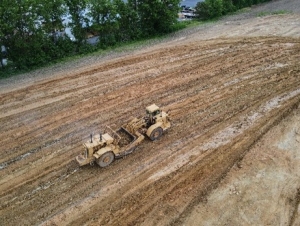A Step-by-Step Guide to the Excavating Process
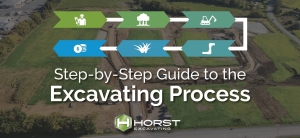
Excavation is an essential process in many commercial and development projects. Your sitework team will take the plot of land and turn it into a clean and clear site ready for construction.
In this blog post, we’ll provide a step-by-step guide to help you understand the excavation process and its various stages. It’s worth noting that the steps below are just a general outline indicative of a “typical” project. However, several of these steps may happen concurrently, some may happen out of order, and some may not happen at all. It all depends on your specific project and your specific site. That said, our list should give you a good idea of what to expect in the excavating process.
So, without further ado, let’s get into it!
- Step 1: Site Assessment & Planning
- Step 2: Clearing
- Step 3: Excavating & Grading
- Step 4: Utilities, Drainage, & Paving
- Step 5: Landscaping & Clean-Up
Step 1: Site Assessment & Planning
Before sitework begins, your team will assess the site and create a plan. This will likely be done by an engineering, architectural, or surveying firm. Their site plan should show the current conditions on your site, including the topography, soil composition, and existing underground utilities and structures. The site plan will also feature the proposed changes, including items like new utilities, drainage, changes in grade, the building’s footprint, pavement, and landscaping.
Sometimes, getting a clear picture of your site’s current conditions can be tricky, especially when it comes to what’s below your site’s surface. But with the proper application of technology, testing, and specialized experience, many teams can get a good idea of what lies beneath. Having an accurate account of below-grade obstructions like rocks can make for a more accurate budget and schedule.
Once your site plan is completed, you can send your documents out for pricing and contractor selection. Then, you’ll forward completed drawings to your municipality for permitting. This part of the process will ensure you’re complying with all development standards and local ordinances.
Many projects will benefit from input provided from the excavating and sitework contractor during this stage. They’ll be able to provide insight into the site’s existing conditions and the site plan in general. When choosing a contractor for this portion of the project, look for one who is eager to jump on board early and work collaboratively with the team. Check out this article to learn more about the benefits of involving a sitework contractor early.
Step 2: Clearing
Once your project’s plan is established and the sitework team is assembled, equipment and their operators will roll out to the site. Their first step is to clear the land. This will include removing unwanted obstacles located above the surface, leaving a smooth and empty slate for the project to begin.
This stage can include the removal of trees, brush, and other vegetation, as well as the demolition of old buildings. The resulting waste will be transported offsite for proper composting, recycling, or disposal. The duration of this phase will vary depending on the time of year, density of vegetation, size of the site, size of the team, and the type of equipment they’re running.
During this phase, your team will need to take all necessary precautions for controlling erosion on the site. While removing vegetation is necessary for the construction of your building, it’ll free up loose soil on the surface. Wind and rain can erode the soil, carrying these particulates into our sewers and waterways. Erosion-control standards are set by local, state, and national organizations. Learn more about common erosion-control methods here.
Step 3: Excavating & Grading
Sturdy, long-lasting buildings start well below the surface. It’s your excavator’s job to create a stable and solid base for your project, which will likely require excavation. As the land clearing process wraps up, your team will work on removing below-grade rocks and organic matter (like large tree roots).
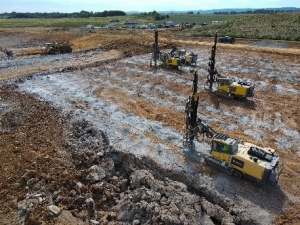
Throughout this process, the team will also work on grading the site. This can include everything from creating perfectly flat building pads and roadways to slopes, swales, and basins for drainage and stormwater management. Once excavation is completed, the team will backfill and compact the site where needed, providing a secure and stable base for your project.
Step 4: Utilities, Drainage & Paving
During or after the excavating and grading phase, your team will work on installing the utilities that will serve your new building. They’ll dig trenches and install infrastructure to support your water, sewage, electrical, cable, phone, and internet connections.
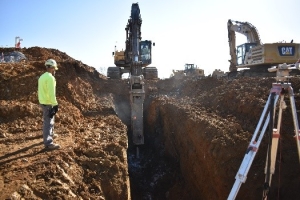
The team will also install drainage infrastructure including pipes, retention or detention ponds, rain gardens, and drains wherever necessary. This will help manage stormwater runoff during and after construction.
Additionally, the team will work on creating any roadways, parking lots, and other paved features. This can happen at different phases of the project, depending on the need for equipment access, parking, and more.
Step 5: Landscaping & Clean-Up
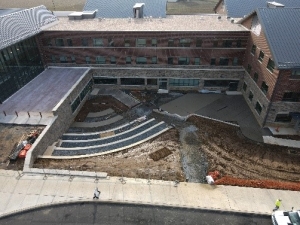
Once the land development portion of the project is completed, the sitework team should clear the site. This includes the removal of all debris, machinery, and remaining materials, leaving the site in a safe and clean condition for the next stage of construction or for the owner to occupy the site.
Choosing the Right Excavator
Understanding the excavation process is essential for anyone involved in a construction or development project. These five steps paint in broad strokes what you can expect from your sitework crew, allowing you to ensure your project runs smoothly and efficiently.
As one of the first contractors on site, the work an excavating team does sets the stage for the rest of the project. Working with the right sitework contractor can set your project up for success, making staying on budget and schedule easier in the long run.
If you’re looking for an experienced, full-service excavation firm, reach out to us today to schedule a free consultation.
Posted February 16, 2023

